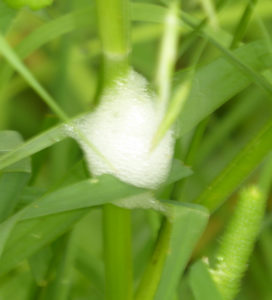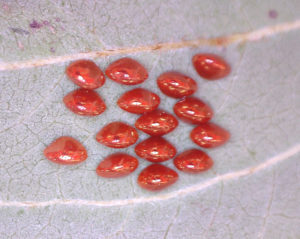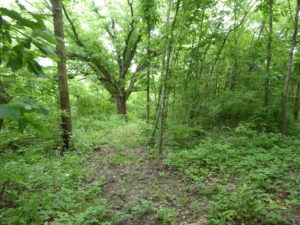June 12, 2018 Second day ASIW
I find it hard to believe that the second day of Art and Science in the Woods has already ended. I continue to be so thankful for all the help provided by Allison, Olivia, Elijah, and Mary. Olivia is with us for the morning major class and Mary is with us for the afternoon minor class. Elijah and Allison are with me all day. Elijah has been recording the many families we encounter as we tour the habitats in the vicinity of the Sun Foundation. I really appreciate his help in writing all the spot identifications down so I can compile this nightly update. The students are keen to learn as much as possible about the insects (and spiders) we encounter. They collect (capture and release) numerous specimens (and most of the families encountered were collected first hand by students in our classes).
Habitats
Today, we focused on oak-hickory forest and aquatic (pond) habitats. Of course, we still have to walk through the old pasture habitat on the way to our tent. We often pass spittle bugs [Heteroptera: Cercopidae] on our walk through the pasture.

The “spittle” is generated by the Cercopidae nymph to hide from predators. The nymph is partly visible near the top of the spittle. It clearly looks unappetizing.
We also encountered some insect eggs (found on the underside of leaves). Here is a photo we took using our digital microscope. It looks like the one in the upper left is about to hatch.

We spent a fair amount of time in the oak-hickory forest. In addition to collecting insects with nets, I also spent some time sifting leaf litter. I placed this in a Winkler eclector and we will check tomorrow to see what we may have found. The habitat is over grown with many low plants (much different from what I observed when I lasted visited this south facing slope almost 15 years ago. There is a large white oak in the background.

More Insect taxa encountered
As we explored the fields and woods, we continued to put together a list of insects we encountered. We were able to identify most to family level. I have organized these below (by order). This is an updated list (new families/ orders encountered are marked with an asterisk). This list expands on the insects encountered on Monday.
For those who are curious about our running total. Over the course of two whole days, we have encountered:
- 15 orders of insects (14 if you exclude Collembola)
- 60 families of insects (59 if you exclude Collembola)
Again, most of these insects were captured by students in the Illinois Insects classes (both major [morning] and minor [afternoon] classes).
Class Entognatha – Subclass Collembola *
Order Entomobryomorpha *
- Family Entomobryidae *
Class Insecta
Order Blattodea *
- Family Ectobiidae (wood cockroach) *
Order Coleoptera
- Family Buprestidae *
- Family Cantharidae (soldier beetles)
- Family Carabidae (ground beetles and tiger beetles) *
- Family Cerambycidae (long horn beetles)
- Tetraopes tetraopthalamus [milkweed beetle]
- Family Chrysomelidae (leaf beetles)
- Family Coccinellidae (lady beetles)
- Family Curculionidae (weevils)
- Family Dytiscidae (predaceous diving beetles) *
- Family Elateridae (click beetles) *
- Family Gyrinidae (whirligig beetles) *
- Family Haliplidae (crawling water beetles) *
- Family Lampyridae (fireflies)
- Family Scarabaeidae (scarab beetles) *
- Popillia japonica [Japanese beetle] *
- Family Silphidae *
Order Dermaptera *
- Family Forficulidae (earwigs) *
Order Diptera
- Family Bombyliidae (bee flies)
- Family Culicidae (mosquitoes)
- Family Dolicopodidae (long legged flies) *
- Family Muscidae (house flies)
- Family Rhagionidae *
- Family Tabanidae (horse flies) *
- Family Tipulidae (crane flies) *
Order Hemiptera
- Family Belostomatidae (giant water bugs) *
- Family Cercopidae (spittle bugs)
- Family Cicadellidae (leaf hoppers)
- Family Coreidae (leaf-footed bugs)
- Family Corixidae (water boatmen) *
- Family Membracidae (tree hoppers)
- Family Myridae (plant bugs) *
- Family Naucoridae (creeping water bugs) *
- Family Nabidae (damsel bugs) *
- Family Reduviidae (assassin bugs)
- Family Scutelleridae (shield-backed bugs)
- Family Veliidae (riffle bugs) *
Order Hymenoptera
- Family Apidae (bumble bees and honey bees)
- Family Formicidae (ants)
- Formica pallidefulva
- Formica exsectoides
- Lasius neomiger *
- Monomorium minimum
- Family Tenthredinidae (sawflies) *
- Family Vespidae (potter wasps and others)
Order Lepidoptera
- Family Erebidae *
- Haploa confusa *
- Haploa confusa *
- Family Geometridae (geometer moths) *
- Family Lycaenidae [blues]
- Family Nymphalide
- Asterocampa celtis [hackberry emperor butterfly]
- Checkerspot butterfly
- Speyeria cybele [great spangled fritillary]
- Family Papilionidae (swallowtails)
- Family Pieridae (sulphurs and whites)
- Family Pyralidae *
- Family Satyridae (wood nymphs)
Order Mantodea
- Family Mantidae
- Tenodera sinensis [Chinese mantis nymphs]
Order Mecoptera
- Family Panorpidae (scorpion-flies)
Order Neuroptera
- Family Chrysopidae (green lacewings(
Order Odonata
- Family Aeschnidae (darners) *
- Family Coenagrionidae (damselflies)
- Family Libellulidae (skimmer dragonflies)
Order Orthoptera
- Family Acrididae (band-wing grasshoppers)
- Family Gryllidae
- Phyllopalpus pulchellus [handsome trig]
- Family Rhaphidophoridae (cave crickets)
- Family Tettigoniidae (katydids) *
- Family Tridactylidae (pygmy mole crickets)
Order Phasmatodea
- Family Diapheromeridae
- Diapheromera femorata (common walkingstick)
Order Thysanoptera *
- Family Thripidae (thrips) *
Other Arthorpods
- Isopods
- Scolopendromorph Centipede
- Spiders (mostly wolf spiders and relatives and Salticidae)
- Geolycosa wrighti was the large brown spider we found in the afternoon)
We covered a lot of ground today as well. My total mileage was over 7 miles again today. Coupled with the 13 miles I walked previously, I have now walked over 20 miles at the Sun Foundation in 2018.